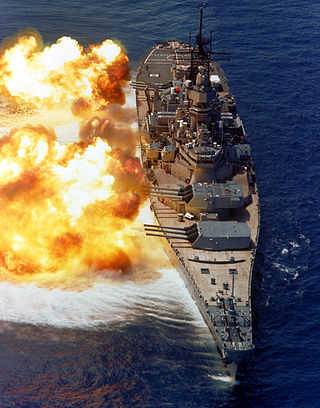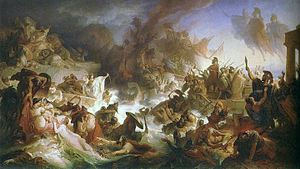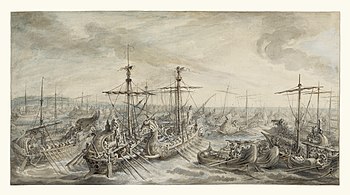
A battleship is a large, heavily armored warship with a main battery consisting of large-caliber guns, designed to serve as capital ships with the most intense firepower. Before the rise of supercarriers, battleships were among the largest and most formidable weapon systems ever built.

A cruiser is a type of warship. Modern cruisers are generally the largest ships in a fleet after aircraft carriers and amphibious assault ships, and can usually perform several operational roles from search-and-destroy to ocean escort to sea denial.

The United States Pacific Fleet (USPACFLT) is a theater-level component command of the United States Navy, located in the Pacific Ocean. It provides naval forces to the Indo-Pacific Command. Fleet headquarters is at Joint Base Pearl Harbor–Hickam, Hawaii, with large secondary facilities at Naval Air Station North Island, California.

The Battle of Leyte Gulf was the largest naval battle of World War II and by some criteria the largest naval battle in history, with over 200,000 naval personnel involved. It was fought in waters near the Philippine islands of Leyte, Samar, and Luzon from 23 to 26 October 1944 between combined American and Australian forces and the Imperial Japanese Navy (IJN), as part of the invasion of Leyte, which aimed to isolate Japan from the colonies that it had occupied in Southeast Asia, a vital source of industrial and oil supplies.

USS Alabama (BB-60) is a retired battleship. She was the fourth and final member of the South Dakota class of fast battleships built for the United States Navy in the 1940s. The first American battleships designed after the Washington treaty system began to break down in the mid-1930s, they took advantage of an escalator clause that allowed increasing the main battery to 16-inch (406 mm) guns, but Congressional refusal to authorize larger battleships kept their displacement close to the Washington limit of 35,000 long tons (36,000 t). A requirement to be armored against the same caliber of guns as they carried, combined with the displacement restriction, resulted in cramped ships. Overcrowding was exacerbated by wartime modifications that considerably strengthened their anti-aircraft batteries and significantly increased their crews.

USS Massachusetts (BB-59) is the third of four South Dakota-class fast battleships built for the United States Navy in the late 1930s. The first American battleships designed after the Washington treaty system began to break down in the mid-1930s, they took advantage of an escalator clause that allowed increasing the main battery to 16-inch (406 mm) guns, but refusal to authorize larger battleships kept their displacement close to the Washington limit of 35,000 long tons (36,000 t). A requirement to be armored against the same caliber of guns as they carried, combined with the displacement restriction, resulted in cramped ships, a problem that was exacerbated by wartime modifications that considerably strengthened their anti-aircraft batteries and significantly increased their crews.

Yamato (大和) was the lead ship of her class of battleships built for the Imperial Japanese Navy (IJN) shortly before World War II. She and her sister ship, Musashi, were the heaviest and most powerfully armed battleships ever constructed, displacing nearly 72,000 tonnes at full load and armed with nine 46 cm (18.1 in) Type 94 main guns, which were the largest guns ever mounted on a warship.

The Battle of the Philippine Sea was a major naval battle of World War II on 19–20 June 1944 that eliminated the Imperial Japanese Navy's ability to conduct large-scale carrier actions. It took place during the United States' amphibious invasion of the Mariana Islands during the Pacific War. The battle was the last of five major "carrier-versus-carrier" engagements between American and Japanese naval forces, and pitted elements of the United States Navy's Fifth Fleet against ships and aircraft of the Imperial Japanese Navy's Mobile Fleet and nearby island garrisons. This was the largest carrier-to-carrier battle in history, involving 24 aircraft carriers, deploying roughly 1,350 carrier-based aircraft.

Haruna (榛名) was a warship of the Imperial Japanese Navy during World War I and World War II. Designed by the British naval engineer George Thurston and named after Mount Haruna, she was the fourth and last battlecruiser of the Kongō class, amongst the most heavily armed ships in any navy when built. Laid down in 1912 at the Kawasaki Shipyards in Kobe, Haruna was formally commissioned in 1915 on the same day as her sister ship, Kirishima. Haruna patrolled off the Chinese coast during World War I. During gunnery drills in 1920, an explosion destroyed one of her guns, damaged the gun turret, and killed seven men.

The Battle off Samar was the centermost action of the Battle of Leyte Gulf, one of the largest naval battles in history, which took place in the Philippine Sea off Samar Island, in the Philippines on October 25, 1944. It was the only major action in the larger battle in which the Americans were largely unprepared. After the previous day's fighting, the Imperial Japanese Navy's First Mobile Striking Force, under the command of Takeo Kurita, had suffered significant damages and appeared to be retreating westward. However, by the next morning, the Japanese force had turned around and resumed its advance toward Leyte Gulf. With Admiral William Halsey Jr. lured into taking his powerful Third Fleet north after a decoy fleet and the Seventh Fleet engaged to the south, the recently-landed 130,000 men of the Sixth Army were left vulnerable to Japanese attack on Leyte.

USS Gambier Bay (CVE-73) was a Casablanca-class escort carrier of the United States Navy. During the Battle off Samar, part of the overall Battle of Leyte Gulf, during a successful effort to turn back a much larger attacking Japanese surface force, Gambier Bay was sunk by naval gunfire, primarily from the battleship Yamato, taking at least 15 hits between 8:10 and 8:40. She was the only American aircraft carrier sunk by enemy surface gunfire during World War II.

USS Minneapolis (CL/CA-36) was a New Orleans-class cruiser built for the United States Navy before the outbreak of World War II, the second ship named for Minneapolis, Minnesota. She served in the Pacific Theater during World War II.

Takeo Kurita was a vice admiral in the Imperial Japanese Navy (IJN) during World War II. Kurita commanded IJN 2nd Fleet, the main Japanese attack force during the Battle of Leyte Gulf, the largest naval battle in history.

USS Helm (DD-388) was a Bagley-class destroyer in the United States Navy during World War II. She was named for Rear Admiral James Meredith Helm. Helm received 11 battle stars for her World War II service in the Pacific.

Crossing the T or capping the T is a classic naval warfare tactic used from the late 19th to the mid-20th centuries in which a line of warships crosses in front of a line of enemy ships to allow the crossing line to bring all their guns to bear while it receives fire from only the forward guns of the enemy.
During World War II, at the beginning of the Pacific War in December 1941, the Imperial Japanese Navy (IJN) was the third most powerful navy in the world, and the naval air service was one of the most potent air forces in the world. During the first six months of the war, the IJN enjoyed spectacular success inflicting heavy defeats on Allied forces, being undefeated in every battle. The attack on Pearl Harbor crippled the battleships of the US Pacific Fleet, while Allied navies were devastated during Japan's conquest of Southeast Asia. Japanese Navy aircraft operating from land bases were also responsible for the sinkings of HMS Prince of Wales and HMS Repulse which was the first time that capital ships were sunk by aerial attack while underway. In April 1942, the Indian Ocean raid drove the Royal Navy from South East Asia. After these successes, the Japanese now concentrated on the elimination and neutralization of strategic points from where the Allies could launch counteroffensives against Japan's conquests. However, at Coral Sea the Japanese were forced to abandon their attempts to isolate Australia while the defeat at Midway saw them forced on the defensive. The campaign in the Solomon Islands, in which the Japanese lost the war of attrition, was the most decisive; they had failed to commit enough forces in sufficient time.

Yahagi (矢矧) was an Agano-class cruiser which served with the Imperial Japanese Navy (IJN) during World War II.

World War II saw the end of the battleship as the dominant force in the world's navies. At the outbreak of the war, large fleets of battleships—many inherited from the dreadnought era decades before—were one of the decisive forces in naval thinking. By the end of the war, battleship construction was all but halted, and almost every remaining battleship was retired or scrapped within a few years of its end.

A fleet action is a naval engagement involving combat between forces that are larger than a squadron on either of the opposing sides. Fleet action is defined by combat and not just manoeuvring of the naval forces strategically, operationally or tactically without engaging. Most famous large naval battles in history were fleet actions. A fleet action is unrelated to participation of any formation that is a named naval fleet, and usually includes only major parts of such formations.
At the beginning of World War II, the Royal Navy was the strongest navy in the world, with the largest number of warships built and with naval bases across the globe. It had over 15 battleships and battlecruisers, 7 aircraft carriers, 66 cruisers, 164 destroyers and 66 submarines. With a massive merchant navy, about a third of the world total, it also dominated shipping. The Royal Navy fought in every theatre from the Atlantic, Mediterranean, freezing Northern routes to Russia and the Pacific ocean.




















